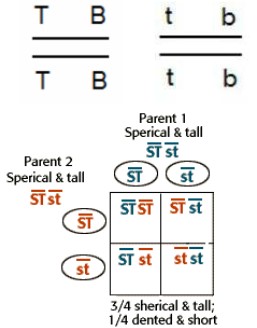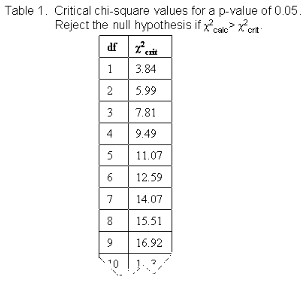Topic 10: Genetics and evolution (HL)
10.2 Inheritance
Dihybrid cross
- A dihybrid cross is a cross between two individuals that shows the inheritance of two different genes at the same time; usually involving unlinked autosomal genes.
- Note: The following example contains two unlinked genes, which means the genes are on different chromosomes. This means they follow Mendel’s law of independent assortment.
- Mendel’s law of independent assortment states allele pairs separate independently from other allele pairs during gamete formation (meiosis).
- Therefore, traits on different chromosomes are transmitted to the offspring independently of traits on other chromosomes.
- An exception to this rule is linked genes
- The standard ratio of phenotypes is 9:3:3:1

- Test cross: unknown genotypes crosses with homozygous receive
- True breed: homozygous
Linked genes:
- Location of genes are on the same chromosome
- The genotypes represented on the right show that T and B are on the same chromosome with one pair on the maternal chromosome and one pair on the paternal chromosome
- The horizontal line represents the homologous chromosomes
- The same can be said about the alleles t and b
- Crossing over can occur between the non-sister chromatids during prophase I of meiosis resulting in offspring with different genotypes
- The gametes Tb and tB could also occur with crossing over, resulting in the recombinant offspring TtBB and TTBb
- Recombinants have different alleles combinations than either of the parents
- When we do not consider crossing over happening, two linked genes will travel together to the gametes, which means, during the punnett square, they need to be considered as a single gene, which gives the standard result of 3:1

Types of variation:
- If variation is discrete it is controlled by alleles of a single gene or a small number of genes. The environment has little effect on this type of variation.
- In this case you either have the characteristic or you don’t. Cystic fibrosis is a good example for this; either you have cystic fibrosis or you don’t. Blood groups are another example of this type of variation. You are either blood type A, B, AB or O, there is no blending of these traits.
- Chi-squared calculations work well when using examples with discrete variation
- In continuous variation there is a complete range of phenotypes that can exist from one extreme to the other. Height is an example of continuous variation as there is a wide assortment of heights of individuals.
- Continuous variation is the combined effect of many genes (known as polygenic inheritance) and is often significantly affected by environmental influences. Skin colour is another example of continuous variation.
Polygenetic traits:
- When one gene controls the expression of a trait, the number of phenotypes that are expressed is limited to the dominant phenotype or recessive phenotype.
- If there is co-dominance, this adds another possible phenotype that can be expressed.
- With polygenic inheritance when two or more genes control the expression of a phenotype many possible phenotypes can exist.
- As the amount of genes that control one trait increase, the number of phenotypes increases to a point where it is impossible to determine the genotype by just observing the phenotype.
- Each additional gene has an additive affect, increasing the phenotypes. This is called continuous variation.
- For example, people’s skin color varies dramatically around the world, between people of different races and within the same race. The multiple genes affect the intensity of the pigments in the skin.
- Another example is human height, which varies from person to person within the same race, and varies between different races. Height shows continuous variation.
- If you graphed the frequency of the occurrence of different phenotypic variations in a population, there should be a normal distribution.
- Continuing with human height, there will be some really tall people and some really short people, but the majority of people will be average height (normal distribution).
- As the number of genes that control a certain trait increases, the closer the distribution of the phenotypes represents a normal distribution.
Chi-square test:
- A chi-square test is a statistical test that can be used to determine whether observed frequencies are significantly different from expected frequencies
- These statistical tests enable us to compare observed and expected frequencies empirically and to decide if the results we see are statistically significant. Statistical significance in this case implies that the differences are not due to chance alone, but instead may be caused by other factors at work.
- This is the formula for a chi-squared test \(x^2=\sum \frac{(o_i-e_i)^2)}{e_i}\), where o means observed
group and e means expected groups - What it basically means is the sum of the (observed minus the expected) squared, divided by
the expected. - We can have two hypothesis out of Chi-square test
- Null hypothesis: data is due to chance and is random due to independent assortment – punnett square ratios are excepted.
- Alternative hypothesis: data is not due to chance and is not random, something influence the data
- Check the value with degree of freedom (0.05 column) corresponding the value of (number of set of data – 1) e.g. 2 phonotypes – 1 set of data.
- If the result is less than the critical value, accept null hypothesis
- If the result is more than the critical value, reject the null hypothesis
